While the world of fungi can be confusing, a few simple steps can get you started with your own mushroom growing. Grow mushrooms to add diversity to your garden, home, or homestead, and enjoy the benefits of safe and healthy mushrooms in your own backyard.
Grow a mushroom garden
Growing ‘shrooms on the homestead often requires sterile technique, that is beyond the scope of most homestead environments. Tissue culture in grain is a hit or miss activity. Mold often spoils a jar of rye seed before the mushroom mycelium has a chance to colonize a jar. For this reason it’s best to do only small jars of tissue culture so that any spoilage is minimized. To increase success commercial mushroom growers have sterile glove boxes, HEPA filters, and expensive flow hoods in a laboratory environment, to minimize contamination of mushroom cultures while doing culture transfers. The expense and the need for special training in sterile culture transfer is enough to discourage most would-be mushroom farmers before they even get started. 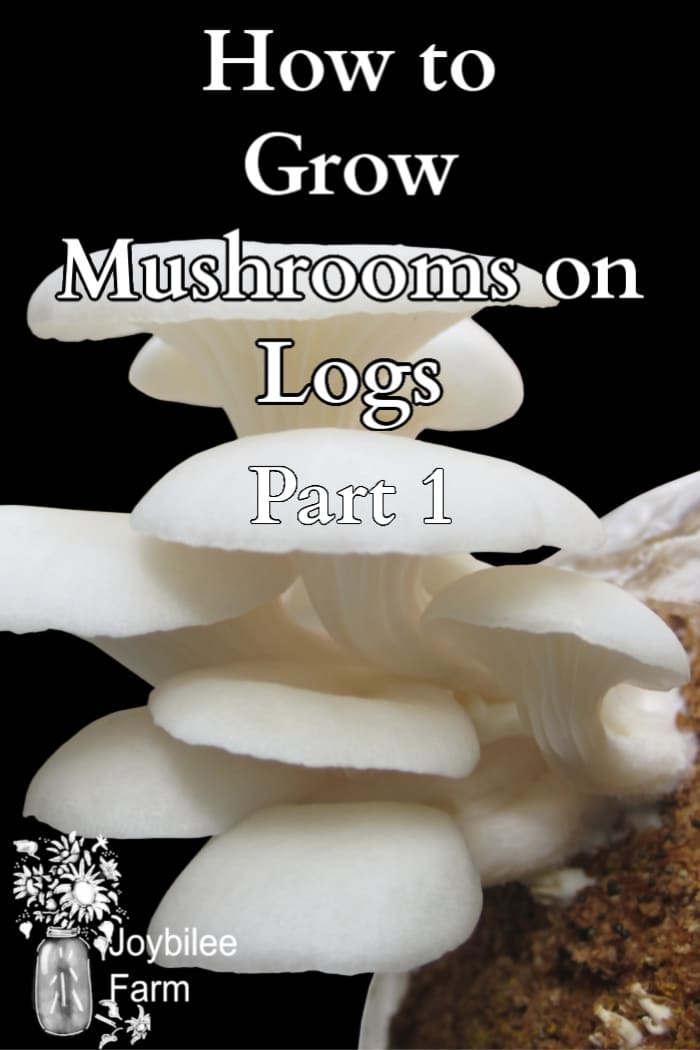
But there are several ways to cultivate mushrooms that don’t require a sterile laboratory set up. Log cultivation of mushrooms is one of the easiest ways to grow mushrooms on the homestead. In log cultivation newly felled trees are inoculated with mushroom fungus and allowed to mature over a season. Once the mycelium has run through the log, and the humidity and temperature are right for the specific mushroom species, the log will fruit, producing a flush or even two of mushrooms, ready to harvest. The log may fruit twice once in spring and again in fall. The log will continue to produce mushrooms for 4 to 6 years before being fully consumed by the fungus. Mushrooms can be a short lived perennial for your homestead when you grow mushrooms on logs.
What yields can I expect?
On average a 4 foot log that is 4 inches in diameter will produce 1 lb of mushrooms each year for 4 years, depending on the type of log. A mushroom garden with 30 logs will give you, on average, 30# of mushrooms divided by two harvest periods. Excess mushrooms can be dried, cooked in sauces and canned or frozen. Mushrooms that are dried in the sun increase their vitamin D content, an important vitamin for the winter months.

What species of mushrooms should I choose?
Shiitake mushrooms and Oyster mushrooms are the easiest mushrooms for a beginner to grow. Other mushrooms suited to log cultivation include Reishi mushrooms, Lions Mane Mushrooms, Maitake, Turkey Tail, and Chicken of the Woods. Save these for cultivating once you’ve had some success with Shiitake and Oyster mushrooms. They are a little trickier and are fussier in the type of wood they fruit on.
There are several strains of both Shiitake and Oyster mushroom to choose from. Check the ideal fruiting temperatures for each variety when making your selections.
Ordering Mushroom Spawn in Canada
If you live in Canada your selection will be more limited. At this writing (2015) mushroom cultures imported into Canada from the USA require a USDA phytosanitary certificate, but not an import permit. I found two sources for mushroom starts in Canada. Mycosource has sawdust spawn for 1 variety of Shiitake mushroom and for “Grey Dove” Oyster mushrooms. MycoBoutique in Quebec has these varieties, as well as the more exotic mushrooms in dowel plugs available for log cultivation. (2021) A good source of mushroom spawn in Western Canada is Grow Mushrooms Canada. They carry several species of both Oyster and Shiitake mushrooms, as well as reishi, turkey tail, and other medicinal mushrooms. I’ve made several orders from them and they are reliable.
Check the requirements of your own country before importing myceliated plugs or sawdust. There are restrictions for importing mushroom cultures to the state of Hawaii, as well.
If you have difficulty importing mushroom cultures where you live, you may be able to successfully tissue culture store bought mushrooms and make your own sawdust spawn from that. Check out this post for instructions.
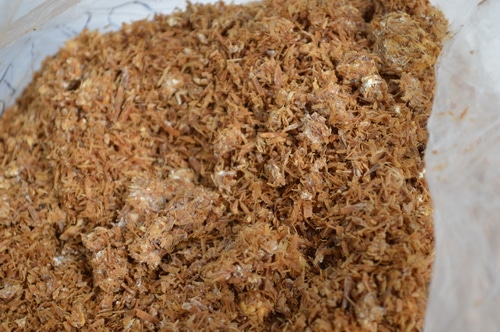
Ordering sawdust spawn or mushroom plugs
You’ll need to order your spawned sawdust or mushroom plugs at least 4 weeks before you want to cultivate your logs. If you order sawdust, you may find heavily myceliated areas in the bag, where the sawdust is completely crusted in white or beige mycelium. There might even be buttons and mushrooms beginning to form. Just break these apart in the bag with the bag still sealed. The tool you use to push sawdust into the logs will help to break these apart, too. If you remove them from the bag, you’ll find that you don’t have much sawdust left to use. The mushrooms don’t begin to fruit until they’ve consumed their substrate, so by the time you see buttons forming a lot of the sawdust has been consumed by the fungi.
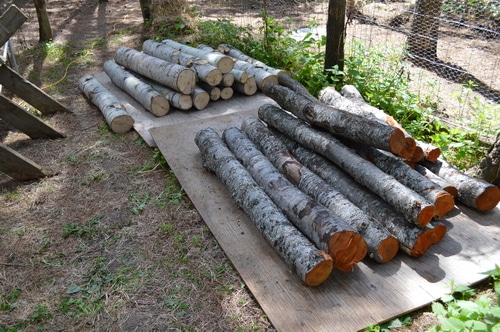
How to prepare your logs
Hardwood logs are used for mushroom cultivation. You won’t find very many edible mushrooms growing on conifers. The piney resins inhibit fungal colonization. I used alder for Shiitake mushrooms and Aspen for Oyster mushrooms in my mushroom project. Oak, maple, cottonwood, poplar and several other hardwoods can be used successfully. If you live in the east where hardwood forests are the norm, lucky you! You’ll find lots of suitable trees in woods near you. Oak and maple are prime. These hardwood logs will give you a few more years of mushroom harvests on each log, compared to the trees I have available here in BC.
Logs that have been lying on the ground for more than 6 months are not suitable for mushroom cultivation.
Prepare your logs by felling fresh trees in the dormant season. Ideally you’ll want to cut down the trees before they leaf out in the spring. This is when the nutrition and sugars are highest in the tree. Look for trees that are 4 to 6 inches in diameter that are free of fungal disease.
You can plug larger logs but they are heavier and more difficult to move and to handle. Cut the logs into 4 foot lengths or to the length that you can easily handle. You’ll need to move the logs occasionally to put them into the ideal position for working with them and then move them again into their fruiting position. So take this into account when you are deciding on how long to cut your logs. Smaller logs tend to dry out faster, though.
Freshly cut logs should be allowed to lie, supported, off the ground, for a month before inoculating. This allows the antifungal activity in the log to stop. The stumps can also be inoculated with sawdust spawn or spawned dowel plugs.
After you’ve plugged the logs you’ll want to keep them in the shade to prevent them from drying out. If you are in an area that doesn’t get much rain, you’ll also want to water them at least once a week to keep the moisture level high and encourage the spawn run.
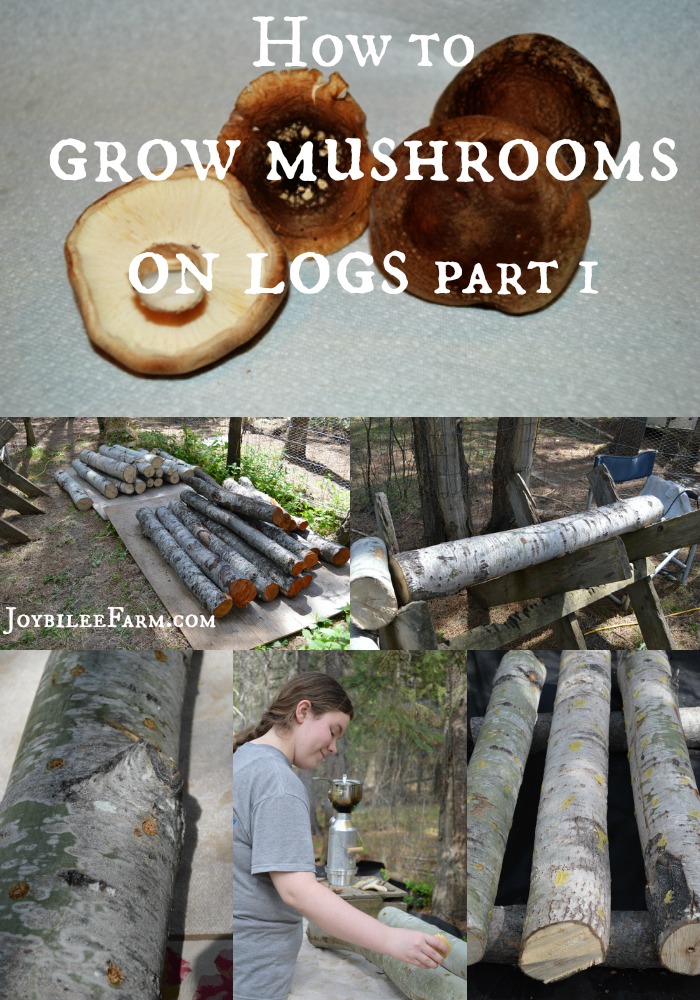
The ideal mushroom yard is…
- In a shady area under the tree canopy. If you lack shade you can set up a shade cloth over a hoop house to keep your logs protected from the drying rays of the sun.
- A fenced area so that you can keep livestock from damaging your cultivated logs and keep creatures away from your fruiting mushrooms. Goats love to jump on logs. That won’t be good. A fence is good.
- A spot that you can easily get supplemental water to the logs during the summer
- With space to move logs around for the resting period, where you want the logs close to the ground, but not on the ground, to keep humidity levels high, and where you can place the logs upright for fruiting.
- A place with room for a soaking tub, where you can soak the logs to encourage fruiting during the growing season. You can promote fruiting by soaking the logs for 24 hours during the growing season.
- A place with room to expand so that you can add fresh logs annually. You can create a perpetual mushroom garden by adding 10 logs of oyster and shiitake mushrooms each year. After 4 years you’ll be getting 80 to 100 lbs of mushrooms a year – 1 lb of mushrooms per log. When shiitake mushrooms are selling for $15 a lb, that’s a tidy profit from your mushroom project, just selling what your own family doesn’t eat.
- A spot where you can protect the logs from pests and predators with landscape fabric and agricultural cloth.
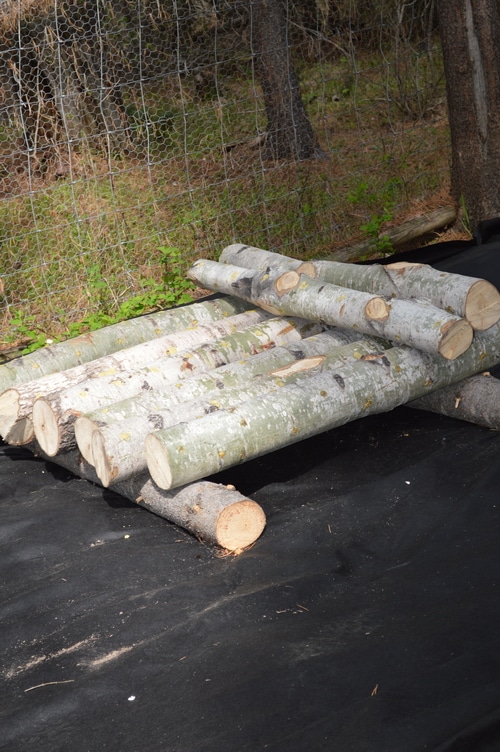
What if a tree falls in the middle of the summer and I want to inoculate the log for mushrooms?
Do it. You only have one chance to decide what kind of fungus will grow in the tree. Guaranteed at least one will colonize it, so you might as well pick which one. While summer inoculation isn’t the ideal, it can’t hurt to try. Wait at least a month after taking the tree down to allow the antifungal activity in the living tree to stop. Inoculate with spawn plugs or sawdust spawn and then keep the tree damp, by watering it in dry spells. You should see evidence of spawn run in 4 to 6 months.
Proceed with caution. A tree laying on the ground can be colonized by less desirable fungi. Know how your species of mushrooms looks before you decide to eat it. Oyster mushrooms and Shiitake mushrooms have a distinctive pleasant mushroom smell, similar to the smell of button mushrooms. When you see the right kind of mushroom starting to fruit on your logs, stand your logs up against a support to make harvest easier, if possible. If the log is too big to move, which might be the case if you inoculate a fallen tree, just harvest the mushrooms where they grow.
See part 2 – How to Grow Mushrooms – Inoculating the logs and preparing your laying yard.
See also How to grow Oyster mushrooms and how to safely forage for mushrooms for more mushroom growing information.
Learn more about growing mushrooms in the garden
Sarah’s new book, Growing Mushrooms for Beginners, A Simple Guide to Cultivating Mushrooms at Home, is available on Amazon and Barnes and Noble. In this concise resource Sarah guides you step by step through growing mushrooms on logs, on straw, on wood chips in the garden, or even in Mason jars in your kitchen. The book includes instructions for growing seven mushrooms including shiitake, oyster, lions mane, garden giant/wine cap, and more. Learn the unique characteristics, flavors, health benefits, and specific growing requirements for each mushroom as well as space saving tips and recipes to get the most out of your mushroom harvest.
Get your copy of Growing Mushrooms for Beginners now.


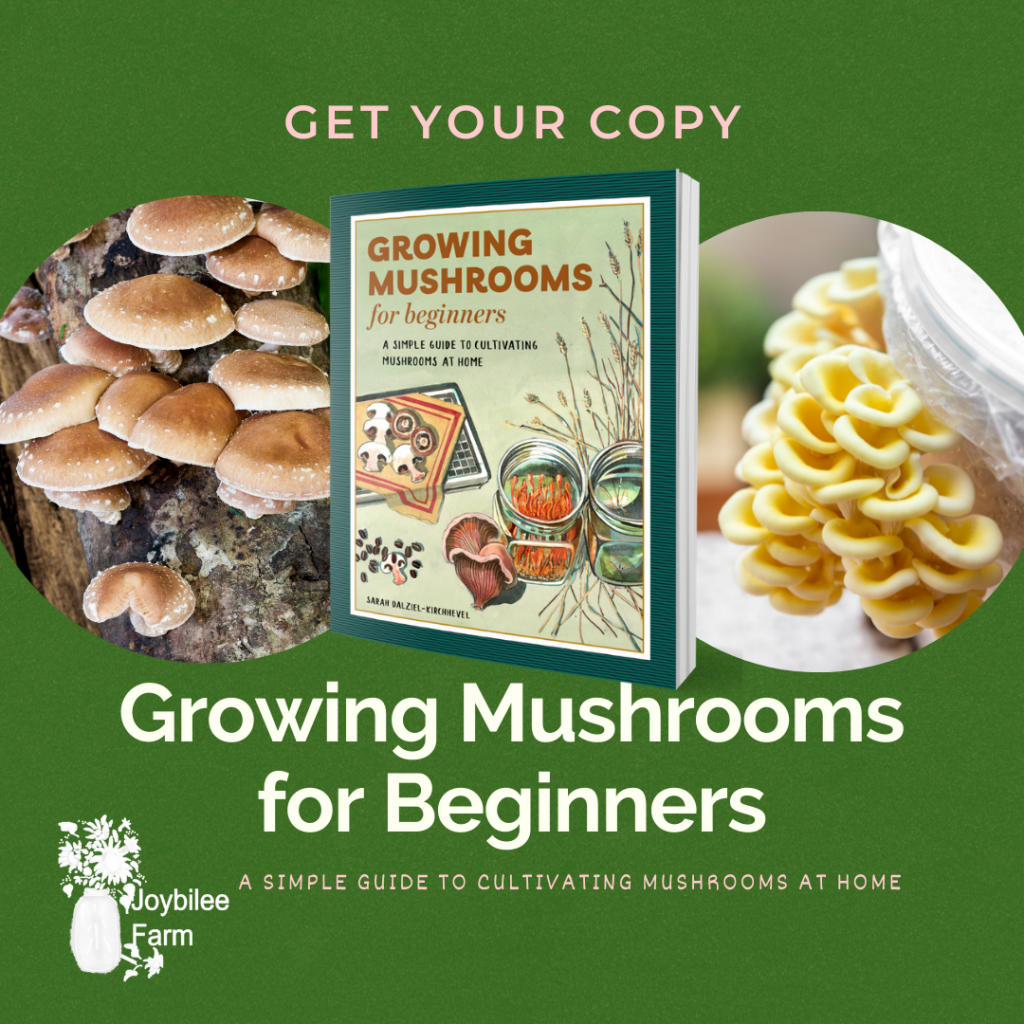


You will want to let the logs stand, off the ground, for a few weeks to let the natural anti-fungal properties of the wood dissipate. Then the logs should be suitable for inoculation.
We recently had a large cottonwood fall due to wind. It’s July, is the wood not suitable for starting mushrooms since you recommend cutting when dormant? Thanks
We also have similar conditions and are curious if you have experimented with the guava and Ohia or found answers/resources elsewhere?